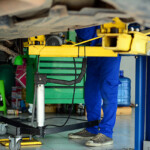Industry Advice Ask Mike: What Are the Biggest Things to Consider When Investing in New Equipment?
with Mike Anderson
This month, we “ASK MIKE” to share his thoughts on the most important things that shops should keep in mind before they purchase new equipment. We at Hammer & Dolly hope you find the following exchange useful, and we encourage you to reach out to us if you have a question for Mike on this or any industry-related matter that he can answer in a future issue.
 Hammer & Dolly: With so many advancements and financial demands impacting the industry these days, equipment purchasing decisions can’t be taken lightly. What are some of the most important things shops should consider before putting down serious money on a new piece of technology?
Hammer & Dolly: With so many advancements and financial demands impacting the industry these days, equipment purchasing decisions can’t be taken lightly. What are some of the most important things shops should consider before putting down serious money on a new piece of technology?
Mike Anderson: Number one, when it comes to equipment, I learned a long time ago to involve technicians in any discussions you have about it. When I still had my shop, I once went out and bought a bunch of dustless vacuum systems that my technicians almost never used. Number two, if I were to buy equipment today, I’d want to know about that equipment’s OEM approvals. If one piece of equipment was approved by multiple manufacturers but another piece was only approved by one, that would obviously influence my purchasing decision.
Equipment servicing is also critically important. If a spray booth goes down, you need to have someone who can fix it promptly. If you’re looking to purchase a frame machine or a welder at the same time you bring on a new technician, is there someone local to you who can help train and onboard that new hire on that equipment?
Also, a lot of the equipment you may see at various shows may be knock off versions of the real thing. That’s not to suggest that the most expensive equipment is always the best, but sometimes you get exactly what you pay for.
A lot of people may get frustrated when an OEM requires a specific brand of tooling for their program. What people don’t always realize is that the equipment manufacturer submitted its products to the OEM to be tested to ensure that things work properly.
I was an Audi-certified shop back when you had to go to Germany. They would show us how they had used a hydraulic press to determine how well different boxes they had welded held up. Some of the boxes welded with their technology at the time held up very well, but other boxes just crushed due to the other type of welding equipment used. People need to keep in mind that OEMs test the equipment so that it performs as needed.
When you purchase equipment, a good rule of thumb is to copy whatever manual comes with it and keep the original on file. Laminate a copy of that manual and attach it to the equipment so that the user can access it easily. These days, there are a lot of manuals that can be downloaded right to a phone.
Shops should also consider the equipment’s maintenance requirements, especially when it comes to anything used as part of a certification program. One of the things I love about Wadsworth – which does in-shop inspections for Subaru, Jaguar and Land Rover – is they insist shops show proof that their torque wrenches have been calibrated. I used to create a ‘maintenance calendar’ at my shop. That way, I’d know that someone would come and adjust my garage doors twice a year or service my compressor every quarter.
Shops should always be proactive with their equipment. If something big breaks down due to neglect, you’re going to be in bad shape.
H&D: What are some equipment trends that you suspect will affect the industry going forward?
MA: Well, the big question mark right now is with ADAS equipment. I’m a big proponent of doing whatever the OEMs say. I’m only going to scan a vehicle with a tool that’s made or approved by the OEM. It’s the same with ADAS calibrations. There are a lot of aftermarket solutions out there. While I understand everyone’s desire to have a one-size-fits-all approach from an economic standpoint, those options are not approved by the OEMs. I’m anxious to see what happens in the future with OEM-approved third-party calibration systems that work for multiple brands.
Something that I would never have thought of 10 years ago is that most – if not all – OEMs now have very specific lighting requirements for shops. The owner of a shop I visited recently told me that they had a certification inspector go to the darkest corner of the facility to see whether the lighting was in spec.
Another thing I’d like to mention about equipment is that shops need to have an asset list kept off-site just in case they have a fire or another catastrophe. I’ve heard horror stories of shops having to replace everything after a fire and not realizing they had so many things. An asset list should be updated at least once a year, and your CPA needs to be kept up to date on any changes. Also, keep pictures of all your equipment and make sure you’re insured properly for whatever you have. Everything – even a mop or a broom – has value. (See “Your Business Insurance Coverage Isn’t Enough!” via grecopublishing.com/hd1024ntlfeature.)
Want more? Check out the November 2024 issue of Hammer & Dolly!
